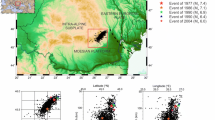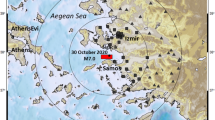Abstract
A better real-time assessment of earthquake effects (i.e. seismic intensity estimation)is crucial for hazard mitigation. Especially during the aftermath of a disastrous event,significant reduction of loss can usually be realized through timely execution ofemergency response measures. These effects include strong-ground shaking, groundfailure, and their impact on man-made structures. The descriptive Modified Mercalliintensity scale, though still in common use in many poorly instrumented areas of theworld, is out of date in areas of extensive strong-motion instrumentation. It is desirableto place the earthquake intensity scale on a more quantitative basis based on the actualrecorded ground-motion shaking and carefully compiled damage records. In this paper,we investigated the relationships between earthquake loss, intensity and strong motionpeak values, mainly based on the Chi-Chi earthquake. Both the strong-motion peakvalues and the earthquake loss are related. From the results, we found that peak groundacceleration (PGA) and peak acceleration response spectra at 1 s period (1 s Sa) valuesare two parameters that give slightly higher correlation coefficients than other parametersfor earthquake loss analysis. For intensity estimations, the peak ground velocity (PGV)values and 1 s Sa values are better parameters in the high range and PGA is not stable forsmaller earthquakes. Although PGV values give a slightly lower correlation coefficientand larger standard deviation in seismic loss analysis during the Chi-Chi earthquake, itnevertheless gives more reliable instrumental intensity over a broad magnitude range.1 s Sa is a good parameter for both seismic losses and intensity evaluation. We thusconclude that PGV and 1 s Sa are relatively more stable in damage assessment and,at least in the high end, in intensity estimation. We shall incorporate these findings inour real-time earthquake rapid reporting and early warning systems.
Similar content being viewed by others

References
Cressie, N. A. C.: 1990, The origins of Kriging, Mathematical Geology 22, 239–252.
Kanamori, H., Hauksson, E., and Heaton, T.: 1997, Real-time seismology and earthquake hazard mitigation, Nature 390, 461–464.
Kanamori, H., Maechling, P., and Hauksson, E.: 1999, Continuous monitoring of ground-motion parameters, Bull. Seism. Soc. Am. 89, 311–316.
Lee, W. H. K., Shin, T. C., Kuo, K. W., Chen, K. C., and Wu, C. F.: 2001, CWB free-field strongmotion data from the 21 September Chi-Chi, Taiwan, earthquake, Bull. Seism. Soc. Am. 91, 1370–1376.
National Office of Statistics: 2000, Summary of important population statistics in 1999 (in Chinese), 921 Earthquake Post-Disaster Recovery Commission, u http:/www.921erc.gov.tw.
National Office of Statistics: 2001, Important statistics about the Chi-Chi earthquake disaster (in Chinese), 921 Earthquake Post-Disaster Recovery Commission, http:/www.921erc.gov.tw.
Ouchi, T., Lin, A., Chen, A., and Maruyama, T.: 2001, The 1999 Chi-Chi (Taiwan) Earthquake: earthquake fault and strong motions, Bull. Seism. Soc. Am. 91, 996–976.
Teng, T. L., Wu, L., Shin, T. C., Tsai, Y. B., and Lee, W. H. K.: 1997, One minute after: strong-motion map, effective epicenter, and effective magnitude, Bull. Seism. Soc. Am. 87, 1209–1219.
Tsai, Y. B., Yu, T. M., Chao, H. L., and Lee, C. P.: 2001, Spatial distribution and age dependence of human-fatality rates from the Chi-Chi, Taiwan, Earthquake of 21 September 1999, Bull. Seism. Soc. Am. 91, 1298–1309.
Wald, D. J., Quitoriano, V., Heaton, T. H., and Kanamori, H.: 1999, Relationships between peak ground acceleration, peak ground velocity and Modified Mercalli Intensity in California, Earthquake Spectra 15, 557–564.
Wu, Y. M., Chen, C. C., Shin, T. C., Tsai, Y. B., Lee, W. H. K., and Teng, T. L.: 1997, Taiwan Rapid Earthquake Information Release System, Seism. Res. Lett. 68, 931–943.
Wu, Y. M., Shin, T. C., and Tsai, Y. B.: 1998, Quick and reliable determination of magnitude for seismic early warning, Bull. Seism. Soc. Am. 88, 1254–1259.
Wu, Y. M., Chung, J. K., Shin, T. C., Hsiao, N. C., Tsai, Y. B., Lee, W. H. K., and Teng, T. L.: 1999, Development of an integrated seismic early warning system in Taiwan-case for the Hualien area earthquakes, TAO 10, 719–736.
Wu, Y. M., Lee, W. H. K., Chen, C. C., Shin, T. C., Teng, T. L., and Tsai, Y. B.: 2000, Performance of the Taiwan Rapid Earthquake Information Release System (RTD) during the 1999 Chi-Chi (Taiwan) earthquake, Seismo. Res. Lett. 71, 338–343.
Wu, Y. M., Shin, T. C., and Chang, C. H.: 2001, Near real-time mapping of peak ground acceleration and peak ground velocity following a strong earthquake, Bull. Seism. Soc. Am. 91, 1218–1228.
Wu, Y. M., Hsiao, N. C., Teng, T. L., and Shin, T. C.: 2002, Near real-time seismic damage assessment of the rapid reporting system, TAO 13, 313–324.
Wu, Y. M., Teng, T. L., Shin, T. C., and Hsiao, N. C.: 2003, Relationship between peak ground acceleration, peak ground velocity, and intensity in Taiwan, Bull. Seism. Soc. Am. 93, 386–396.
Wu, Y. M. and Teng, T. L.: 2002, A virtual subnetwork approach to earthquake early warning, Bull. Seism. Soc. Am. 92, 2008–2018.
Author information
Authors and Affiliations
Rights and permissions
About this article
Cite this article
Wu, YM., Hsiao, NC. & Teng, TL. Relationships between Strong Ground Motion Peak Values and Seismic Loss during the 1999 Chi-Chi, Taiwan Earthquake. Natural Hazards 32, 357–373 (2004). https://doi.org/10.1023/B:NHAZ.0000035550.36929.d0
Issue Date:
DOI: https://doi.org/10.1023/B:NHAZ.0000035550.36929.d0



